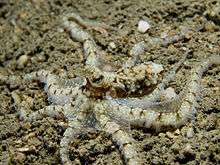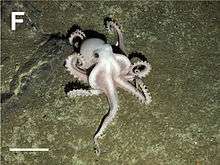Incirrata
Incirrata (or Incirrina) is a suborder of the order Octopoda. The suborder contains the classic "benthic octopuses," as well as many pelagic octopus families, including the paper nautiluses. The incirrate octopuses are distinguished from the cirrate octopuses by the absence in the former of the "cirri" filaments (found with the suckers) for which the cirrates are named, as well as by the lack of paired swimming fins on the head, and lack of a small internal shell (the "shell" of Argonauta species is not a true shell, but a thin calcite egg case).
| Incirrata | |
|---|---|
 | |
| An octopus active during the night in the coastal waters of northern East Timor | |
 | |
| An unidentified octopus observed on East Scotia Ridge at a depth of 2,394 m (scale bar: 10 cm)[1] | |
| Scientific classification | |
| Kingdom: | Animalia |
| Phylum: | Mollusca |
| Class: | Cephalopoda |
| Order: | Octopoda |
| Suborder: | Incirrata Grimpe, 1916 |
| Families | |
| |
| Synonyms | |
| |
Classification
- CLASS CEPHALOPODA
- Subclass Nautiloidea: nautilus
- Subclass †Ammonoidea: ammonites
- Subclass Coleoidea
- Superorder Decapodiformes: squid, cuttlefish
- Superorder Octopodiformes
- Family †Trachyteuthididae (incertae sedis)
- Order Vampyromorphida: vampire squid
- Order Octopoda
- Genus †Keuppia (incertae sedis)
- Genus †Palaeoctopus (incertae sedis)
- Genus †Paleocirroteuthis (incertae sedis)
- Genus †Pohlsepia (incertae sedis)
- Genus †Proteroctopus (incertae sedis)
- Genus †Styletoctopus (incertae sedis)
- Suborder Cirrina: finned deep-sea octopus
- Suborder Incirrata
- Superfamily Octopodoidea
- Family Amphitretidae
- subfamily Amphitretinae
- subfamily Bolitaeninae
- subfamily Vitreledonellinae
- Family Bathypolypodidae
- Family Eledonidae
- Family Enteroctopodidae
- Family Megaleledonidae
- Family Octopodidae
- Family Amphitretidae
- Superfamily Argonautoidea
- Family Alloposidae: seven-arm octopus
- Family Argonautidae: argonauts
- Family Ocythoidae: tuberculate pelagic octopus
- Family Tremoctopodidae: blanket octopus
- Superfamily Octopodoidea
Note: A new unnamed white species was discovered February 26, 2016 by NOAA’s Deep Discoverer about 2.5 miles below the ocean surface near the Hawaiian Archipelago.[2]
gollark: Yes, I'm aware you can do it, but no.
gollark: No.
gollark: I would update if it people had good ideas.
gollark: Like what?
gollark: It does that.
References
- Rogers, A. D.; Tyler, P. A.; Connelly, D. P.; Copley, J. T.; James, R.; Larter, R. D.; Linse, K.; Mills, R. A.; Garabato, A. N.; Pancost, R. D.; Pearce, D. A.; Polunin, N. V.; German, C. R.; Shank, T.; Boersch-Supan, P. H.; Alker, B. J.; Aquilina, A.; Bennett, S. A.; Clarke, A.; Dinley, R. J.; Graham, A. G.; Green, D. R.; Hawkes, J. A.; Hepburn, L.; Hilario, A.; Huvenne, V. A.; Marsh, L.; Ramirez-Llodra, E.; Reid, W. D.; Roterman, C. N. (2012). Eisen, Jonathan A. (ed.). "The discovery of new deep-sea hydrothermal vent communities in the Southern Ocean and implications for biogeography". PLoS Biology. 10 (1): e1001234. doi:10.1371/journal.pbio.1001234. PMC 3250512. PMID 22235194.
- "Ghost octopod shows how little we know about deep-sea life". Smithsonian Science News -. Retrieved 2016-03-09.
This article is issued from Wikipedia. The text is licensed under Creative Commons - Attribution - Sharealike. Additional terms may apply for the media files.